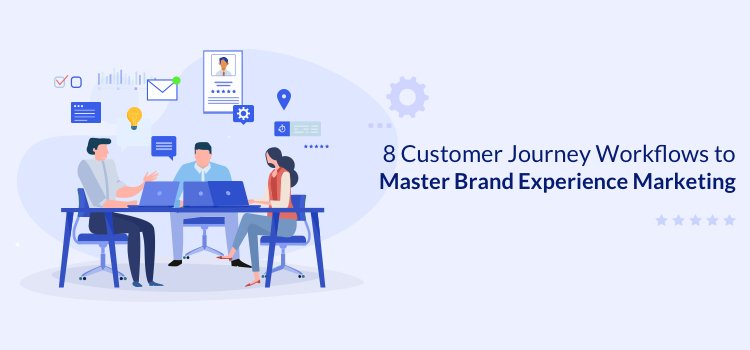8 Customer Journey Workflows to Master Brand Experience Marketing
As marketers, we don’t just want customers to know our brands, we want customers to experience our brands. But, what does that mean?
Well, first of all, brand experience is the thoughts and feelings that are evoked by your brand, not just what your products do or what your brand looks like. So, focusing on the sensory experience your customers and prospects have with your brand will help encourage a long-term and meaningful relationship with your brand. LinkedIn suggests that eventually, the importance of the customer experience will overtake the price and quality of products. Focusing on brand experience marketing will help you get there.
One of the ways in which to master brand experience marketing is to take a deeper look at your customer’s journey. Mapping the customer journey is only the beginning if you want to step up your brand experience marketing. Mapping each point in the journey and creating individual workflows will help you dig deeper into the customer journey.
Customer Journey Workflows
Creating workflows has become an important strategy for most businesses, especially within sales and marketing. Lead nurturing, for instance, lends itself very nicely to workflows so that you can break down the whole process and convert much more effectively. With all this workflow creation experience, it’s only natural for marketers to build a more strategic customer journey map by creating individual workflows for each part of the journey.
Mapping your customer journey helps you understand how to give customers the experience they need. Creating workflows will map the tasks and processes to create that experience. Once complete, you will have both a visual customer journey map and a diagram workflow so you can understand your customers better.
Customer journeys for different products and businesses will differ, however, the basic idea of how your customer takes the journey from awareness to loyalty is pretty standard and can be used for this purpose. Here are eight workflows you can create based on the customer journey to increase your brand experience marketing significantly:
1. Awareness Workflow
The awareness and selection phase of the customer journey is about providing information about how your product will help resolve a pain point your customers commonly have and helping them select the right product.
Creating a workflow around this phase will help you see where customers tend to have their first interaction with your brand, what you want them to do next, and the individual tasks that will need to go into it to make it happen.
2. Purchase Workflow
Once your prospects understand the benefits of your product and are aware it exists, you’ll want to work on how best to get them to purchase. Building the workflow will show you the point of the transaction and whether or not they purchase.
The purchase workflow can also show options when purchases aren’t made in order to get them back to the point of a potential purchase.
3. Deployment Workflow
Once the purchase is made, a workflow detailing deployment can tell you how best to provide a successful installation and onboarding experience. Determine what your customer should be responsible for and what your organization is responsible for when deploying.
4. Customization Workflow
Once installed, create a workflow that shows the ways in which the product can be personalized for each individual customer. Determine the configuration settings that can be customized and those that would benefit your customers the most along their journey.
5. Educational Workflow
As part of creating a successful onboarding process, formulate a workflow that shows what the learning experience should be like for your end-users. This is a good place to determine where you’ll have future touchpoints with your customers to find out if they need any further training.
6. Product Improvement Workflow
As part of the customer journey that helps you build trust with your customers, create a workflow regarding your product improvements and how and when to share the information with your customers. Letting them know you are continuously improving your products will help them feel at ease with their purchase and more likely to purchase in the future.
7. Maintenance Workflow
Closely tied to the phase in your customer journey that helps you build trust is where you will be providing maintenance and how you will communicate this information to your customers.
8. Loyalty Workflow
Finally, you’ll want to know how you’ll be sharing your enhancements and investments into the security of your products so your current customers will become future loyal customers. According to Review42, 65% of the business that organizations receive comes from previous customers. Loyalty is important.
Conclusion
According to TrustPilot, focusing on customer experience is the best way to differentiate yourself from the competition. So, in an oversaturated market or with under-priced competitors, you can still stand out with better customer experience. Focusing on brand experience marketing will help.
One of the most effective ways to create and capture all of the information you need for your brand experience marketing strategy is an all-in-one customer relationship management tool such as Agile CRM. With the ability to create, store, and access all of your customer information from one place and automate sales and marketing processes, you’ll be able to focus on improving your customer experience significantly.
Whichever way you choose to create your customer journey maps and brand experience marketing strategy, you’ll be glad you did when you see successful results time and again.

No Comments